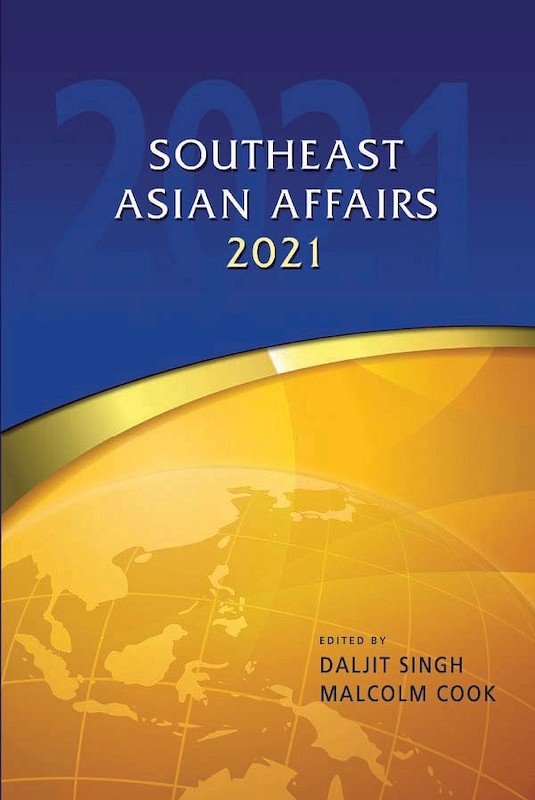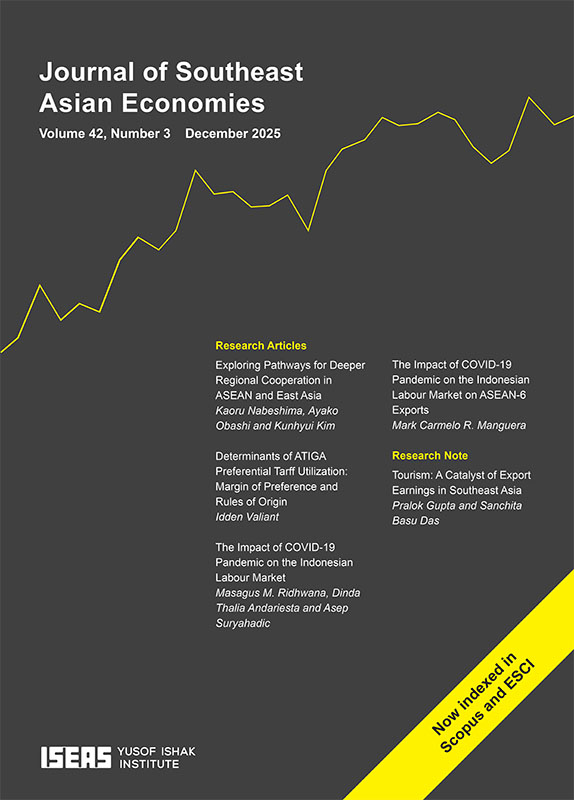Journal of Southeast Asian Economies Vol. 39/3 (December 2022)

Date of publication:
October 2022
Publisher:
ISEAS – Yusof Ishak Institute
Number of pages:
123
Code:
AE39/3
Soft Cover
ISSN: 23395095
Contents
-
Journal of Southeast Asian Economies Vol. 39/3 (December 2022).
[Whole Publication, ISSN: 23395206] -
Preliminary pages
- RESEARCH ARTICLES
-
Avoiding the Resource Curse: Lessons from Indonesia, by Hal Hill, Donny Harrison Pasaribu, authors see abstractNatural resources—blessing or curse? Indonesia provides an excellent case study for an examination of this question. It is a major commodity exporter; the fourth most populous country in the world; and the world’s largest archipelagic state with huge mineral, forest and maritime resources. Indonesia also has three distinctive features that are particularly relevant for such a study. First, with the exception of the Asian Financial and COVID-19 crises, it has had at least moderately strong economic performance for the past half-century. This distinguishes it from the majority of resource-rich developing countries, and therefore there are lessons to be learnt from its management of these boom and bust episodes, particularly the latter. Second, Indonesia has experienced two rather different resource booms—the first based mainly on oil and gas in the 1970s and the second based primarily on coal, palm oil and gas over the years 2005–11. The economic, social and environmental effects of these two booms have differed significantly. Third, the country experienced major regime change in 1998–99, from the centralized, authoritarian Soeharto regime in 1966–98, which presided over the first boom, to the subsequent democratic, decentralized regime during the second boom. The very different political and institutional arrangements had important implications for the management of the boom and its distributional effects. We examine these issues in a comparative context, employing as reference points two very large natural resource exporters, Brazil and Nigeria, and Malaysia, a smaller, more dynamic Southeast Asian comparator.
-
How Far Has India Integrated with East Asian Economies? Evidence from International Trade Data, by Mitsuyo Ando, Kenta Yamanouchi, Fukunari Kimura, authors see abstractSince the 1990s, East Asia—including Northeast and Southeast Asia—has led the world in adopting a task-by-task international division of labour or international production networks (IPNs), the core of which consists of machinery industries. In this regard, how far has India integrated with East Asia? Using international trade data for comparison from multiple perspectives, this article gives an overview of the current position of India with respect to machinery IPNs and information and communication technology (ICT) services. The article shows that India has not yet participated in machinery IPNs in the East Asian region. We argue that ICT services are a source of strength for the Indian economy, and its competitiveness could be utilized effectively by combining new technologies with traditional industries such as manufacturing. India still has huge untapped opportunities for utilizing the mechanics of a new international division of labour to accelerate economic growth, innovation and poverty alleviation. And economic integration with East Asia could work as a trigger to redirect India’s industrialization strategies.
-
Estimating the Impact of Selected Macroeconomic Indicators on Remittance Inflows in the Philippines, by John Paolo R Rivera, Tereso S Tullao, Jr., authors see abstractAs economic activities came to a standstill during the COVID-19 pandemic, the Philippines, like many economies across the globe, experienced rising inflation, currency depreciation and fluctuating capital markets. To manage these variables and stabilize the macroeconomy, the central bank resorted to monetary tightening. In the Philippines, a key mechanism that contributes to this stabilizing effect rests on remittances that have been cushioning the economy from the effects of volatilities and uncertainties in the global economy. During economic downturns and reduced capital flows, remittances provide support not only to recipient households but also to the country’s financial sector. Using time series analysis, we estimate the response of remittance inflows on impulses from selected macroeconomic variables, namely interest rate, inflation rate and exchange rate. A common characteristic shared by the selected indicators is their influence on recipient households’ consumption-related decision-making process. These findings warrant the need to redesign major institutional policies to manage remittances in light of their anticipated feedback effect on the economy.
-
Do Exports from Developing Economies Still Matter in Global Value Chains? Evidence from Malaysia, Thailand and Vietnam, by Lee Woocheol, author see abstractAmid ever-growing global value chains (GVCs), a major controversial topic relates to the extent to which developing economies benefit from participating in such value chains. To measure these gains, this paper examines data pertaining to value-added in exports from three Southeast Asian economies—Malaysia, Thailand and Vietnam. The study estimates the sectoral income elasticities of the export demand of each country over the period 1980–2017, revealing that the highest income elasticities are observed in low value-adding sectors such as primary products, resource-based goods and low-tech industries. This implies that the three countries have been involved in simple and not high-skill tasks within GVCs. The paper also examines the sectoral domestic share of value-added (DVA) and foreign share of value-added (FVA) of exports of the three economies using the OECD Trade in Value-added (TiVA) database over the period 2005–15. We find that DVA in the medium- and high-tech industries that add greater value is smaller than FVA in all three countries. Overall, these results suggest that developing nations need to step up their participation in GVCs through process and/or function upgrading.
- RESEARCH NOTES
-
The Vulnerability of Jobs to Mobility Restrictions: Malaysia’s Experience during the COVID-19 Pandemic, by Amanina Abdur Rahman, Alyssa Farha Jasmin, Achim Schmillen, authors see abstractUsing the mobility restrictions implemented by Malaysia during the COVID-19 pandemic as a case study, this paper relies on detailed data on employment patterns and on the possibility to work from home and without physical proximity to estimate the extent and distribution of jobs most vulnerable to mobility restrictions. It finds that about 64.5 per cent of jobs in Malaysia cannot be performed from home, after adjusting for Internet access, while about 50.9 per cent of jobs require high levels of physical proximity. These are the jobs that are most vulnerable to strict mobility restrictions, such as those imposed during the pandemic. Workers most at risk are primarily those with relatively low education, low level of income and advanced or very young age. Jobs in less developed regions of Malaysia are also particularly vulnerable. Against this backdrop, the paper argues that Malaysia’s experience during the COVID-19 pandemic provides some vital lessons in supporting those who are most vulnerable to job losses during mobility restrictions. These lessons include improving the targeting of cash transfers, scaling up wage subsidies in supporting worker retention and hiring and leveraging upskilling/reskilling initiatives with a focus on non-routine cognitive analytical and interpersonal skills.
-
Effects of the COVID-19 Pandemic on the Labour Market in Thailand, by Nattanicha Chairassamee, Oudom Hean, authors see abstractThis study aims to explore the labour market in Thailand during the COVID-19 era. By using individual data from the National Statistical Office of Thailand, we estimate the probability of a worker becoming unemployed and being temporarily absent from work. The results demonstrate that the pandemic could cause a higher chance of being unemployed for younger workers. However, the chance of being temporarily absent from work increased for older and less-educated workers. Each sector was affected differently by the pandemic. Workers in large firms were more likely to be unemployed, suggesting that the pandemic disproportionately affected large firms, compared to micro, small or medium-sized enterprises.
- BOOK REVIEWS
-
BOOK REVIEW: Handbook on Global Value Chains, edited by Stefano Ponte, Gary Gereffi and Gale Raj-Rechhert, by Cassey Lee, author
-
BOOK REVIEW: In the Shadow of the Palms: More-Than-Human Becomings in West Papua, by Sophie Chao, by Serina Rahman, author
-
BOOK REVIEW: The Economic Consequences of Globalization on Thailand, by Juthathip Jongwanich, by Piyapong Sangkaew, author






